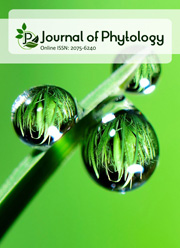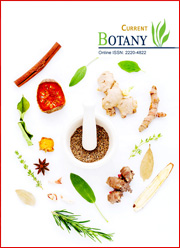The Effect of solvent, pH, extraction time and temperature on the extraction of phenolic compounds and antioxidant activity of Carpobrotus edulis
DOI:
https://doi.org/10.25081/jp.2024.v16.8393Keywords:
Carpobrotus edulis, Phenolic compounds, Antioxidant activity, Factorial designAbstract
Two 23 factorial design studies were performed to determine the effect of solvent, pH, extraction time and temperature on the extraction of phenolics and radical scavenging activity contained in crude leaf extracts of Carpobrotus edulis. For the aqueous model, pH 9, 72 h and 40 °C provided the highest yield (31.03 ± 0.58%), while the highest yield for the methanolic extracts was obtained using the same temperature and pH, but with a longer extraction time of 168 h (64.21 ± 2.12%). Quantitative phytochemical analysis was performed to determine the amount of phenolics, tannins and flavonoids contained in the crude extracts. When water was used as an extraction solvent, the highest concentration of phenolics was obtained using pH 9 and extracting for 72 h at 40 °C (6.42 ± 0.03 milligrams Gallic Acid Equivalent per gram of extract). However, when methanol was used as a solvent, the highest concentration of phenolics was obtained when the same pH and time of extraction was used, but at a lower temperature (25 °C) – 7.44 ± 0.50 mg GAE/g of extract. Antioxidant activity was determined using the ABTS and DPPH assays. For both, methanol extracts produced lower IC50 values than the aqueous extracts. The best combination of extraction conditions for aqueous extracts is pH 9, and 72 h of extraction at 40 °C. This produced the lowest IC50 values for both assays (298.28 μg/mL for DPPH and 140.77 μg/mL for ABTS assay). When methanol is used as a solvent, the extraction conditions producing the lowest IC50 values were pH 9, 72 h and 25 °C for the DPPH assay (109.84 μg/mL), and pH 5, 168 h and 25 °C for the ABTS assay (26.79 μg/mL). These values are all higher than for the positive control, ascorbic acid. A positive correlation exists between phenolic content and radical scavenging activity – higher phenolic content resulted in higher radical scavenging activity. Pearson’s correlation coefficient was higher for the aqueous extracts than for the methanol extracts. Thus, extraction conditions must be modified to maximise extraction of phenolics, to obtain maximum radical scavenging activity.
Downloads
References
Ainsworth, E. A., & Gillespie, K. M. (2007). Estimation of total phenolic content and other oxidation substrates in plant tissues using Folin-Ciocalteu reagent. Nature Protocols, 2, 875-877. https://doi.org/10.1038/nprot.2007.102
Alam, M. N., Bristi, N. J., & Rafiquzzaman, M. (2012). Review on in vivo and in vitro methods evaluation of antioxidant activity. Saudi Pharmaceutical Journal, 21(2), 143-152. https://doi.org/10.1016/j.jsps.2012.05.002
Bazzicalupo, M., Cornara, L., Burlando, B., Cascini, A., Denaro, M., Smeriglio, A., & Trombetta, D. (2021). Carpobrotus edulis (L.) N.E.Br. extract as a skin preserving agent: From traditional medicine to scientific validation. Journal of Integrative Medicine, 19(6), 526-536. https://doi.org/10.1016/j.joim.2021.09.002
Chang, C.-C., Yang, M.-H., Wen, H.-M., & Chern, J.-C. (2002). Estimation of total flavonoid content in propolis by two complementary colorimetric methods. Journal of Food and Drug Analysis, 10(3), 178-182. https://doi.org/10.38212/2224-6614.2748
Chen, W.-C., Liou, S.-S., Tzeng, T.-F., Lee, S.-L., & Liu, I.-M. (2013). Effect of topical application of chlorogenic acid on excision wound healing in rats. Planta Medica, 79(08), 616-621. https://doi.org/10.1055/s-0032-1328364
Conforti, F., Sosa, S., Marrelli, M., Menichini, F., Statti, G. A., Uzunov, D., Tubaro, A., Menichini, F., & Loggia, R. D. (2008). In vivo anti-inflammatory and in vitro antioxidant activities of Mediterranean dietary plants. Journal of Ethnopharmacology, 116(1), 144-151. https://doi.org/10.1016/j.jep.2007.11.015
Cotelle, N. (2001). Role of flavonoids in oxidative stress. Current Topics in Medicinal Chemistry, 1(6), 569-590. https://doi.org/10.2174/1568026013394750
Custódio, L., Ferreira, A. C., Pereira, H., Silvestre, L., Vizetto-Duarte, C., Barreira, L., Rauter, A. P., Albericio, F., & Varela, J. (2012). The marine halophytes Carpobrotus edulis L. and Arthrocnemum macrostachyum L. are potential sources of nutritionally important PUFAs and metabolites with antioxidant, metal chelating and anticholinesterase inhibitory activities. Botanica Marina, 55(3), 281-288. https://doi.org/10.1515/bot-2012-0098
De Beer, J. J. J., & Van Wyk, B.-E. (2011). An ethnobotanical survey of the Agter–Hantam, Northern Cape Province, South Africa. South African Journal of Botany, 77I(3), 741-754. https://doi.org/10.1016/j.sajb.2011.03.013
Falleh, H., Ksouri, R., Medini, F., Guyot, S., Abdelly, C., & Magné, C. (2011). Antioxidant activity and phenolic composition of the medicinal and edible halophyte Mesembryanthemum edule L. Industrial Crops and Products, 34(1), 1066-1071. https://doi.org/10.1016/j.indcrop.2011.03.018
Hausladen, A., & Stamler, J. S. (1999). Nitrosative stress. In L. Packer (Eds.), Methods in E nzymology (Vol. 300, pp. 389-395) Cambridge, US: Academic Press. https://doi.org/10.1016/S0076-6879(99)00143-3
Kalita, P., Tapan, B. K., Pal, T. K., & Kalita, R. (2013). Estimation of total flavonoids content (tfc) and antioxidant activities of methanolic whole plant extract of Biophytum sensitivum Linn. Journal of Drug Delivery and Therapeutics, 3(4), 33-37. https://doi.org/10.22270/jddt.v3i4.546
Lee, K. J., Oh, Y. C., Cho, W. K., & Ma, J. Y. (2015). Antioxidant and anti-inflammatory activity determination of one hundred kinds of pure chemical compounds using offline and online screening HPLC assay. Evidence-Based Complementary and Alternative Medicine, 2015, 165457. https://doi.org/10.1155/2015/165457
Martins, A., Vasas, A., Schelz, Z. S., Viveiros, M., Molnar, J., Hohmann, J., & Amaral, L. (2010). Constituents of Carpobrotus edulis inhibit P-glycoprotein of MDR1- transfected mouse lymphoma cells. Anticancer Research, 30(3), 829-835.
Mulaudzi, R. B., Aremu, A. O., Rengasamy, K. R. R., Adebayo, S. A., McGaw, L. J., Amoo, S. O., Van Staden, J., & Du Plooy, C. P. (2019). Antidiabetic, anti-inflammatory, anticholinesterase and cytotoxicity determination of two Carpobrotus species. South African Journal of Botany, 125, 142-148. https://doi.org/10.1016/j.sajb.2019.07.007
Omoruyi, B. E., Afolayan, A. J., & Bradley, G. (2014). Chemical composition profiling and antifungal activity of the essential oil and plant extracts of Mesembryanthemum edule (L.) bolus leaves. African Journal of Traditional, Complementary, and Alternative Medicines, 11(4), 19-30. https://doi.org/10.4314/ajtcam.v11i4.4
Omoruyi, B. E., Bradley, G., & Afolayan, A. J. (2012). Antioxidant and phytochemical properties of Carpobrotus edulis (L.) bolus leaf used for the management of common infections in HIV/AIDS patients in Eastern Cape Province. BMC Complementary Medicine and Therapies, 12, 215. https://doi.org/10.1186/1472-6882-12-215
Ordway, D., Hohmann, J., Viveiros, M., Viveiros, A., Molnar, J., Leandro, C., Arroz, M. J., Gracio, M. A., & Amaral, L. (2003). Carpobrotus edulis methanol extract inhibits the MDR efflux pumps, enhances killing of phagocytosed S. aureus and promotes immune modulation. Phytotherapy Research, 17(5), 512-519. https://doi.org/10.1002/ptr.1314
Prieto, J. M. (2012). Procedure: Preparation of DPPH radical, and antioxidant scavenging assay (microplate protocol). Dr Prieto's DPPH Microplate Protocol, 1-3.
Rahman, K. (2007). Studies on free radicals, antioxidants and co-factors. Clinical Interventions in Aging, 2(2), 219-236.
Re, R., Pellegrini, N., Proteggente, A., Pannala, A., Yang, M., & Rice-Evans, C. (1999). Antioxidant activity applying an improved ABTS radical cation decolorization assay. Free Radical Biology and Medicine, 26(9-10), 1231-1237. https://doi.org/10.1016/S0891-5849(98)00315-3
Rocha, M. I., Rodrigues, M. J., Pereira, C., Pereira, H., da Silva, M. M., da Rosa Neng, N., Nogueira, J. M. F., Varela, J., Barreira, L., & Custódio, L. (2017). Biochemical profile and in vitro neuroprotective properties of Carpobrotus edulis L., a medicinal and edible halophyte native to the coast of South Africa. South African Journal of Botany, 111, 222-231. https://doi.org/10.1016/j.sajb.2017.03.036
Scalbert, A., Manach, C., Morand, C., Rémésy, C., & Jiménez, L. (2005). Dietary polyphenols and the prevention of diseases. Critical Reviews in Food Science and Nutrition, 45(4), 287-306. https://doi.org/10.1080/1040869059096
Spectranomics. (2011). Total phenol and tannin determination in fresh leaves. Carnegie Institution for Science.
Subedi, L., Timalsena, S., Duwati, P., Thapa, R., Paudel, A., & Parajuli, K. (2014). Antioxidant activity and phenol and flavonoid contents of eight medicinal plants from Western Nepal. Journal of Traditional Chinese Medicine, 34(5), 584-590. https://doi.org/10.1016/S0254-6272(15)30067-4
Terblanche, U. (2020). The effect of Carpobrotus edulis and Cotyledon orbiculata on the migration, proliferation and differentiation of keratinocytes in vitro. Doctoral Dissertation, Vaal University of Technology.
Tiwari, P., Kumar, B., Kaur, M., Kaur, G., & Kaur, H. (2011). Phytochemical screening and Extraction: A Review. Internationale Pharmaceutica Sciencia, 1(1), 98-106.
Trabelsi, N., Falleh, H., Jallali, I., Daly, A. B., Hajlaoui, H., Smaoui, A., Abdelly, C., & Ksouri, R. (2012). Variation of phenolic composition and biological activities in Limoniastrum monopetalum L. organs. Acta Physiologiae Plantarum, 34, 87-96. https://doi.org/10.1007/s11738-011-0807-8
Trabelsi, N., Waffo-Téguo, P., Snoussi, M., Ksouri, R., Mérillon, J. M., Smaoui, A., & Abdelly, C. (2013). Variability of phenolic composition and biological activities of two Tunisian halophyte species. Acta Physiologiae Plantarum, 35, 749-761. https://doi.org/10.1007/s11738-012-1115-7
van der Watt, E., & Pretorius, J. C. (2001). Purification and identification of active antibacterial components in Carpobrotus edulis L. Journal of Ethnopharmacology, 76(1), 87-91. https://doi.org/10.1016/S0378-8741(01)00197-0
van Wyk, B.-E. (2008). A review of Khoi-San and Cape Dutch medical ethnobotany. Journal of Ethnopharmacology, 119(3), 331-341. https://doi.org/10.1016/j.jep.2008.07.021
Van Wyk, B.-E., van Oudsthoorn, B., & Gericke, N. (2009). Medicinal Plants of South Africa. (2nd ed.). Pretoria, South Africa: Briza Publications.
Published
How to Cite
Issue
Section
Copyright (c) 2024 N. Laloo, U. Terblanche, C. C. Ssemakalu, M. Pillay

This work is licensed under a Creative Commons Attribution 4.0 International License.





 .
.